The Bar Shouldered Dove is a medium-sized long-tailed dove that is native to Australia and Papua New Guinea.
This dove is also known as the Scrub Dove, the Mangrove Dove, and the Kookawook.
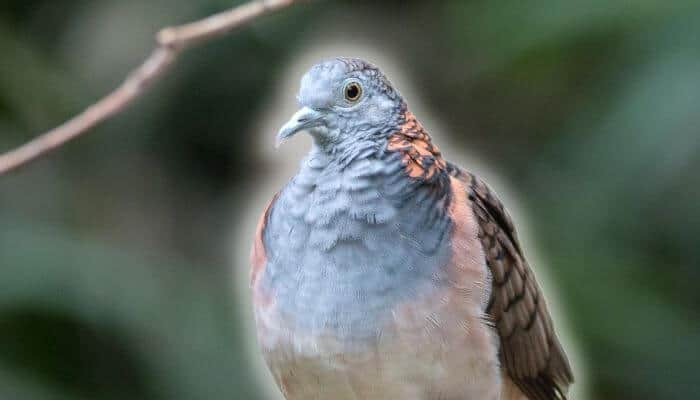
Bar Shouldered Doves are commonly seen in northern and eastern Australia.
Origins of the Bar-Shouldered Dove
The Bar Shouldered Dove (Geopelia humeralis) was first described by Dutch zoologist Coenraad Jacob Temminck in 1821.
The name Geopelia comes from Ancient Greek meaning ground dove (geo meaning ground and peleia meaning dove).
The doves within this genus are long-tailed doves that mainly eat seeds that they forage for on the ground.
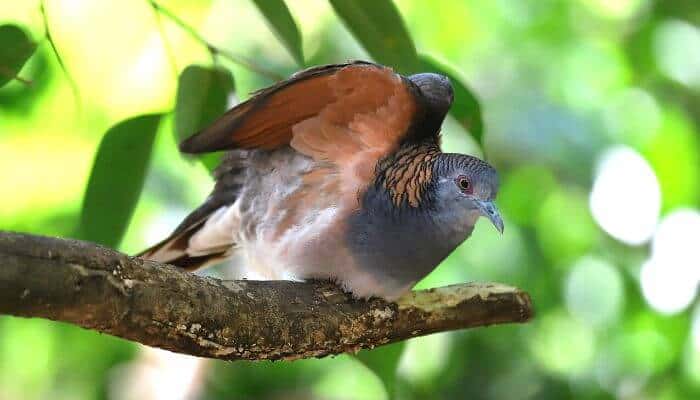
These doves are gray-brown in color and have a pattern of either spots or bars across their plumage.
The Bar Shouldered Dove looks similar to the Spotted Turtle Dove (Streptopelia chinensis) in size and shape.
They are also similar to the Peaceful Dove and the Diamond Dove but the Bar Shouldered Doves are much larger in size.
Distribution & Habitat of the Bar Shouldered Dove
Bar Shouldered Doves are found in humid, grassy woodland and forest across northern and eastern Australia as well as southern Papua New Guinea. They usually live near wetlands and also occur in mangroves.
Bar Shouldered Doves can also be seen in urban areas and are particularly common in Darwin and Cairns.

In addition to humid forests, these doves are found in a number of artificial habitats including pastures, arable land, and former subtropical/ tropical forest that has been heavily degraded.
Bar Shouldered Doves are sedentary, they do not migrate and there is no evidence of seasonal movements.
Closest Columbidae Relatives of the Bar Shouldered Dove
The Bar Shouldered Dove has a northern subspecies (Geopelia humeralis headlandi) that is found only in the Pilbara region.
The subspecies is lighter in color but aside from this there is no other notable difference.
The Bar Shouldered Dove is part of the Geopelia, or long-tailed dove, genus.
The genus was introduced in 1837 with the zebra dove as the type species. There are 5 species in this genus including:
Zebra Dove (Geopelia striata)
The Zebra Dove is native to southeast Asia and is also a popular bird in captivity.
Zebra doves are slightly smaller than the Bar Shouldered Dove and are brownish-gray with black and white barring.
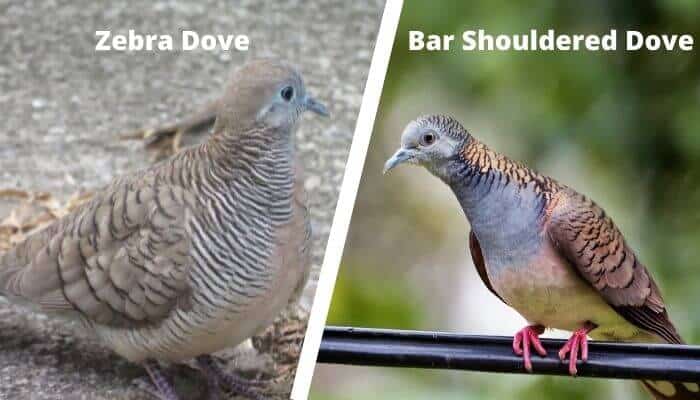
The Zebra dove is small in size, they are around 20-23cm in length and weigh 50-60g.
Diamond Dove (Geopelia cuneata)
The Diamond Dove is one of Australia’s smallest pigeons and is much smaller than the Bar Shouldered Dove. They weigh 28-40g and are very delicate looking.
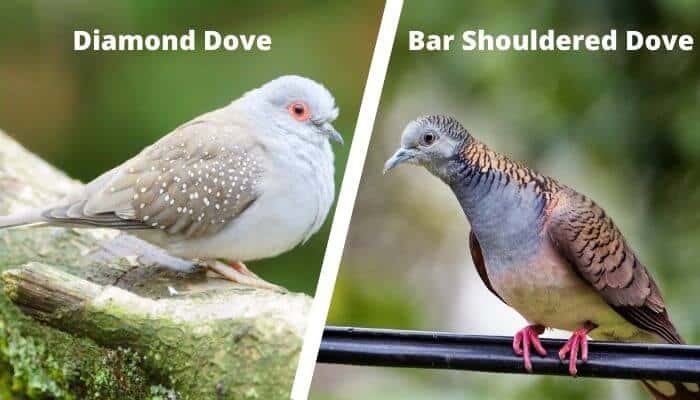
Diamond Doves have distinctive pale spots of their wings and red eye rings making them easy to identify.
Peaceful Dove (Geopelia placida)
The Peaceful Dove is native to Australia and New Guinea. Previously the Peaceful Dove, Zebra Dove, and Barred Dove were believed to be a single species.
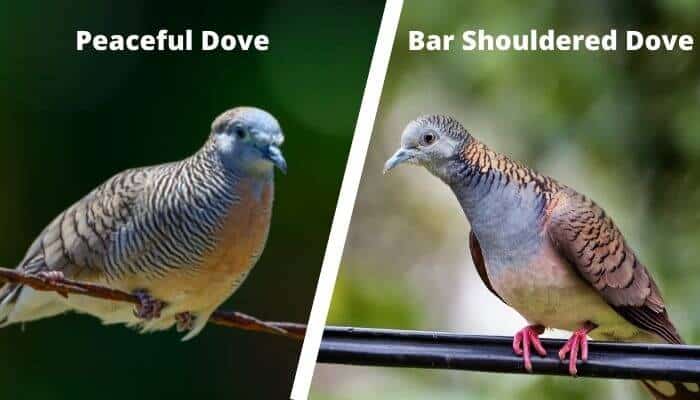
The Peaceful Dove is a small pigeon with similar striated nape feathers to the Bar Shouldered Dove.
Barred Dove (Geopelia maugeus)
The Barred Dove is endemic to the Lesser Sunda Islands in Indonesia.
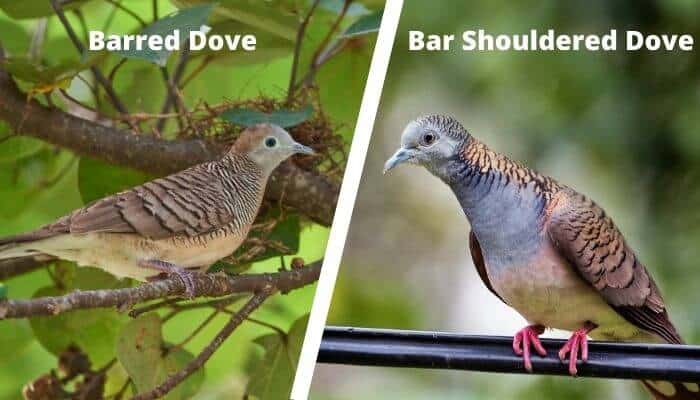
A key difference between the Barred Dove and the Zebra Dove is the black and white barring across the breast and belly and the bare yellow skin around the Barred Dove’s eye.
Bar Shouldered Dove Appearance
This medium-sized dove is blue-gray in color and has a patch of red-bronze coloring on the back of their neck.
They also have dark barring across their back and the lower breast has a pinkish bar across it. The upper breast, neck, and head of this dove is blue-gray in color.
The lower part of the dove’s body is slightly paler and Bar Shouldered Doves have reddish eyes with a blue-gray eye ring.
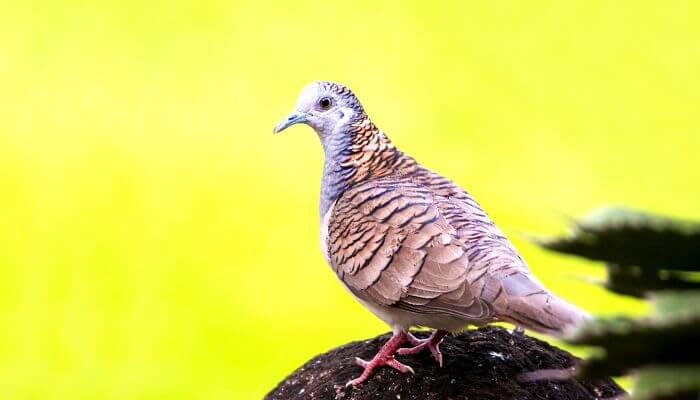
They have a long, thin gray beak and reddish-orange legs and claws.
The tail feathers of the Bar Shouldered Dove make up almost half of their length. The tail is long and thin and is the same brownish-gray color as the rest of the body.
Although male and female Bar Shouldered Doves are visually very similar they are sexually dimorphic as the females are duller in color compared to the males.
Juvenile doves are also duller in color and do not have the reddish-bronze patch on the back of their neck. They have a gray-brown bill and a brownish-gray iris and orbital ring. The juveniles will molt to adult plumage within the first year.
| Wingspan | Length | Weight | Coloring | |
|---|---|---|---|---|
| Bar Shouldered Dove | Unknown | 27-30cm | 108-150g | Blue-gray face & chest, brown wings back & stomach |
| Average Feral Pigeon | 64 – 72 cm | 32 – 37 cm | 300 – 500 g | Bluish gray with some black |
Facts About The Bar Shouldered Dove
- Common in urban areas
- Need to live near water sources as they need to drink multiple times a day
- Often confused with the Spotted Turtle Dove
- Protected under the National Parks and Wildlife Act 1974
Bar Shouldered Dove Conservation
The Bar Shouldered Dove is listed as least concern on the IUCN Red List.
These birds have a large range and a stable population, although it is not known exactly how many individuals there are.
Bar Shouldered Doves are frequently seen in Australia (predominantly in the north and east of the country).
These birds are particularly abundant in northern Australia and protected under the National Parks and Wildlife Act 1974. The Bar Shouldered Dove is a common street-bird in Cairns and Darwin.
This species appears to have benefited from agricultural clearing as the clearing provides fields for foraging.
These doves can be found in a wide range of natural and artificial landscapes including urban areas.
Bar Shouldered Dove Character
Bar Shouldered Doves are usually seen in pairs or small groups. They are commonly seen feeding on seeds on the ground or visiting water sources but they are never too far from cover.
These doves have a loud, distinctive and melodious “kookawook” call. The call is often a 6-note repeating phrase (low, low, high – low, low high).
This is a well-known call for those sharing Australia’s urban areas with these birds.
The flight of the Bar Shouldered Dove is swift and direct, and their thick wings whistle while in flight.
Diet
Bar Shouldered Doves mainly eat seeds. They can be seen foraging in short grass for seeds of grass, sedges, herbs, and rhizomes (roots). Bar Shouldered Doves are often seen on the ground searching for food.
These birds are never far from cover and they are often close to water sources as they will go to the water to drink a few times each day.
Mating And Breeding Bar-Shouldered Doves
Breeding season for Bar Shouldered Doves is between August and November in the south and is year-round in the north where it is warmer.
These doves nest in dense trees or shrubs. They will make a thin platform on a branch or a fork using roots and twigs.
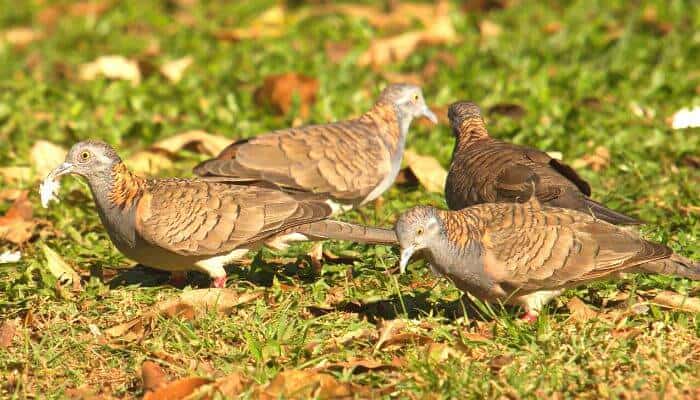
The female will lay 2 white, glossy eggs and both parents will work together to incubate the 2 eggs and care for the chicks.
The newborn chicks will first be fed crop milk. The incubation period for the Bar Shouldered Dove eggs is 14 days and the time in the nest is 21 days.
Caring for Bar-Shouldered Doves
Bar Shouldered Doves are a wild protected species so they cannot be kept as pets. There are some of these birds kept in zoos around the world.
The diamond dove and zebra dove (two of the species within the same family as the Bar Shouldered Dove) are commonly kept in captivity.
The best way to care for Bar Shouldered Doves is to support the conservation of their habitat. Fortunately, these doves are common across their range and are not currently considered to be at risk of extinction.
